Eaton Canyon
Eaton Canyon is a major canyon beginning at the Eaton Saddle near Mount Markham and San Gabriel Peak in the San Gabriel Mountains in the Angeles National Forest, United States. Its drainage flows into the Rio Hondo river and then into the Los Angeles River.[1] It is named after Judge Benjamin S. Eaton, who lived in the Fair Oaks Ranch House in 1865 not far from Eaton Creek.[2]
| Eaton Canyon | |
|---|---|
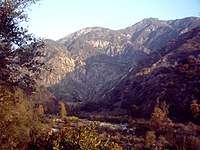 Eaton Canyon with toll road bridge in background | |
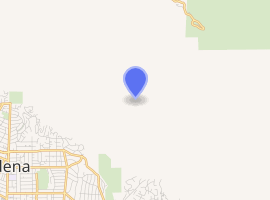
| |
| Nearest city | Pasadena, California |
| Coordinates | |
The most well-known portion of the canyon is the Eaton Canyon Nature Center in Pasadena, California. The trailhead of the Mount Wilson Toll Road is in the canyon.[3][4]
History
Eaton Canyon is in the foothills of the San Gabriel Mountains. Originally called "El Precipicio" by the Spanish settlers because of its steep gorges, the canyon falls under several governmental jurisdictions.[2]
Benjamin Eaton was hired by Don Benito Wilson to bring water to the Fair Oaks Ranch.[5] In August 1877, naturalist John Muir set out from Pasadena for an expedition into the San Gabriels. He writes: "On the first day of my excursion I went only as far as the mouth of Eaton Canyon, because the heat was oppressive, and a pair of new shoes were chafing my feet to such an extent that walking began to be painful."[6][7][8]
On October 27, 1993, the floor of Eaton Canyon, along with 118 surrounding homes, was devastated by a wildfire.[9]
Landmarks
Eaton Canyon Natural Area Park

The Eaton Canyon Natural Area Park is located where the mountain stream debouches into the foothill wash at the base of the San Gabriel Mountains. The park is administered by the Los Angeles County Department of Parks and Recreation. The county administers the lower two-thirds of the area below the toll road bridge. Most of the 190 acres (0.8 km2) that comprises the natural area lie on the northern boundaries of the old Rancho San Pascual and Rancho Santa Anita on land designated for the Southern Pacific Railroad. Once the railroad gave up the land, it was opened for homesteading.[2] The nature center is unique in the area because it houses exhibits that educate on the flora and fauna local to the San Gabriel Valley Southern California. The center was rebuilt in 1998 after the 1993 fire destroyed the previous facility.[5][10]
Pasadena and parts of Altadena receive about 40% of their water from local sources.[2] The upper third is controlled by the Water Department of the City of Pasadena.[5][10]
- 34.177233°N 118.097°W - Eaton Canyon Park
Eaton Canyon Falls
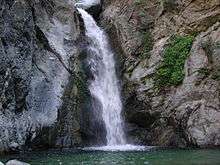
The falls are where the Eaton Creek has a fifty-foot drop and are located north of the bridge in the part of the canyon administered by the US Forest Service.[11] John Muir once described the waterfall as "a charming little thing, with a low, sweet voice, singing like a bird, as it pours from a notch in a short ledge, some thirty or forty feet into a round mirror-pool."[12]
Several waterfalls also exist above Eaton Fall, which are more secluded. Until 1979, there was a tunnel which allowed access, but this has been dynamited and filled in. While the upper falls were accessible decades ago, there are no longer any maintained trails. People have been injured and killed trying to make these climbs.
On July 31, 2011, a man fell to his death on the hike to the falls.[13] Another man fell to his death one week later on August 6, 2011.[14]
On March 22, 2013, two hikers tried to climb to the second waterfall, but decided against it mid-climb. As they made their way down, they both lost their footing and fell. One hiker, a high school senior, fell to her death, and the other was airlifted for treatment.
On June 27, 2014, the US Forest Service announced plans to close the trail to the upper falls. The trail to the upper falls was closed off on August 1, 2014. Violators caught trespassing the off-limits area will face a fine of up to $5,000 or six months in jail.[15][16]
- 34.1966°N 118.1028°W - Eaton Canyon falls
Golf course
The Eaton Canyon Golf Course is a regulation 9-hole course featuring narrow fairways and rolling terrain. It is administered by the Los Angeles County Department of Parks and Recreation[17] and has been open since 1962.[18]
It was originally planned as an eighteen-hole facility and was designed by famed golf course architect, William Francis Bell (known as Billy Bell, Jr., son of famed golf course designer, William Park Bell). Opening day ceremonies included a golf outing with dignitaries and local golf professionals, including 1961 PGA Champion, Jerry Barber.[18]
- 34.1658°N 118.1044°W - Eaton Canyon Park Golf Course
Mount Wilson Toll Road
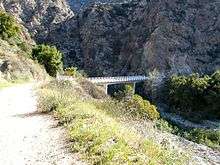
The Mount Wilson Toll Road (1891–1936) is a historic roadway which ascended Mount Wilson via a vehicular passable road from the base of the foothills in Altadena. It was accessible from Pasadena via Santa Anita Avenue which drove right to the front porch of the toll house. The road is still accessible from Pinecrest Drive, just off Altadena Drive in Altadena. Access was blocked after a 2005 landslide destroyed 50 yards of the road, but the road has since been rebuilt and reopened.
Mount Wilson had always been active with human passage starting from the days of the local Indians. It was Benjamin Davis Wilson who established a proper trail to the summit of Mt. Wilson from Sierra Madre through the Santa Anita Canyon. The Mt. Wilson Toll Road to Henninger Flats is controlled by the Forester and Fire Warden of the Los Angeles County Fire Department.
- 34.19189°N 118.1044°W - Mt. Wilson Toll Road trail head
Eaton Wash
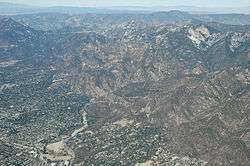
Emerging from the foothills and flowing south, the Eaton Creek becomes the Eaton Wash, whose drainage flows into the Rio Hondo river and then into the Los Angeles River. The wash is one of the Altadena streams that helps to feed to Raymond Basin. Rubio, Las Flores and others all flow to the east eventually to join the Rio Hondo. Millard Canyon on the west flows to the Arroyo Seco. Eaton Wash is one of the two major streams that channels storm water in Pasadena; the other is the Arroyo Seco on the western side of the city.[19]
On its way to the Rio Hondo, the Eaton Wash is joined by the combined drainages from Pasadena Glen and Hastings Canyons. These channels have all been modified by flood control dams near the base of the mountains, and both have been confined to manmade channels or storm drains in their lower reaches. Typically the Eaton Wash and Arroyo Seco carry very little water. Peak discharges are typically less than 1,000 ft³/s (30 m³/s) for Arroyo Seco and less than 500 ft³/s (15 m³/s) for Eaton Wash.
- 34.0694°N 118.056°W - Eaton Wash, USGS El Monte (CA)
Eaton Canyon Reservoir and Dam
Eaton Wash Reservoir and the Eaton Wash Dam were built in 1937 and are controlled by the Los Angeles County Department of Public Works. The dam is a rock fill, 63 feet (19 m) in height, and is 1,545 ft (471 m) in length. Normal storage for the reservoir is 721 acre feet (889,000 m3). It has a surface area of 54 acres (220,000 m2) and drains an area of 9.47 square miles (25 km2). Its primary usage is for flood control and debris storage.[20][21]
- 34.17°N 118.09134°W - Eaton Canyon Reservoir
- 34.1692°N 118.09°W - Eaton Wash Dam
References
- "Eaton Canyon Nature Center Associates". Archived from the original on 2007-04-29. Retrieved 2007-05-24.
- "Eaton Canyon". Eaton Canyon Nature Center Associates history. Archived from the original on 2007-06-09. Retrieved 2007-05-24.
- Robinson, Joe (2005-11-15). "What a washout". Los Angeles Times.
- "Hiking". Pasadena Convention and Visitors Bureau. Archived from the original on 2007-04-11. Retrieved 2007-05-24.
- Tom Chester; Jane Strong. "Eaton Canyon". Field Guide to the San Gabriel Mountains: Places. Retrieved 2010-06-20.
- John McKinney. "Eaton Canyon". Trailmaster. Retrieved 2019-02-04.
- Muir, John (1918). The San Gabriel Mountains. Steep Trails. Yosemite Online.
chapter 11
- Daniel E. Simpson. "Eaton Canyon Falls". Dan's Hiking Pages. Retrieved 2019-02-07.
- "Eaton Canyon Trail - CA: Southern California Hikes". trails.com. Retrieved 2019-12-04.
- "Eaton Canyon Natural Area Los Angeles County Department of Public Resources". Los Angeles Education Partnership. Archived from the original on 2002-10-30. Retrieved 2002-10-30.
- "Eaton Canyon Falls". Archived from the original on 2007-06-03. Retrieved 2007-05-30.
- "Los Angeles - Eaton Canyon". GoCityKids. Archived from the original on 2007-09-28. Retrieved 2007-05-30.
- Saillant, Catherine (2011-08-01). "Man falls to his death on popular Pasadena hiking trail". Los Angeles Times. Retrieved 2011-08-01.
- Schaefer, Samantha (2011-08-06). "Angeles Forest hiker falls to death". Los Angeles Times. Retrieved 2011-08-06.
- Jeanne Kuang; Kim Baldonado (2014-06-26). "Forest Service to Close Dangerous Stretch of Eaton Canyon". NBC Los Angeles. Retrieved 2019-12-04.
- Melissa Pamer (2014-07-30). "Eaton Canyon Upper Falls Closure Begins Friday: Forest Service". KTLA. Retrieved 2019-12-04.
- "Los Angeles County Parks and Rec > Eaton Canyon". lacountyparks.org. Retrieved 2007-09-28.
- "Eaton Canyon Golf Course". dcgolf.info. Archived from the original on 2008-04-30. Retrieved 2008-04-30.
- Tim Brick. "The Arroyo Seco Watershed Restoration Feasibility Study" (PDF). Arroyo Seco Foundation. Retrieved 2003-11-25.
- "WRD: 2001-2002 Hydrologic Report-> Reservoirs". Archived from the original on 2007-10-06. Retrieved 2007-05-31.
- "EATON CANYON RESERVOIR". EPA Water Assessment. EPA. Retrieved 2009-07-09.
External links
| Wikimedia Commons has media related to Eaton Canyon (California). |
- "Eaton Canyon Natural Area".
- "Adventure Hikes and Canyoneering in the San Gabriels - Lower Eaton Canyon".
- "Adventure Hikes and Canyoneering in the San Gabriels - Upper Eaton Canyon". Archived from the original on 2013-08-14. Retrieved 2013-01-09.
(includes map of entire canyon)
- "Chronology of Eaton Canyon". Archived from the original on 2007-06-09. Retrieved 2007-05-30.
- "Flora of Lower Eaton Canyon".
- "Rescue July 20, 2013". Retrieved 2013-07-22.
- "What will save Altadena hikers from themselves at Eaton Canyon?". 2013-07-22. Retrieved 2013-07-23.
- "July 27, 2013, Hiker Rescued After 35-foot Fall in Eaton Canyon". 2013-07-28.
- Video of LA County Sheriff's Deputy rescuing climbers in Eaton Canyon on YouTube
- Photos tagged with Canyon/ "Eaton Canyon" at Flickr